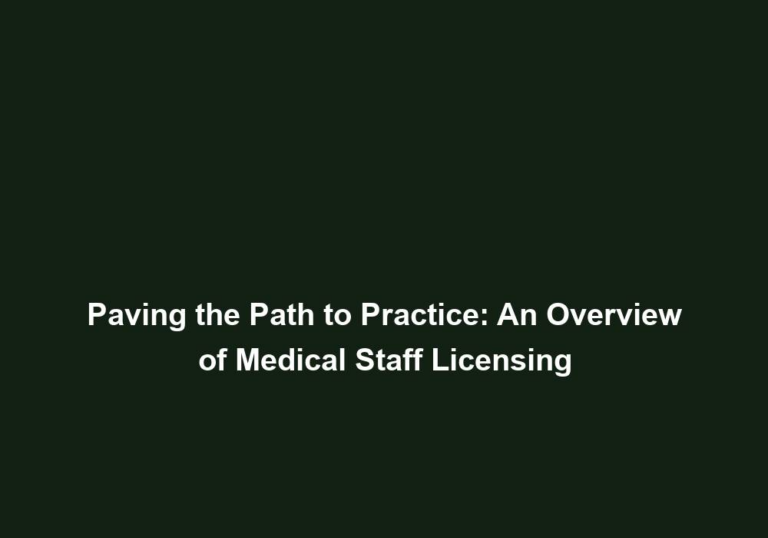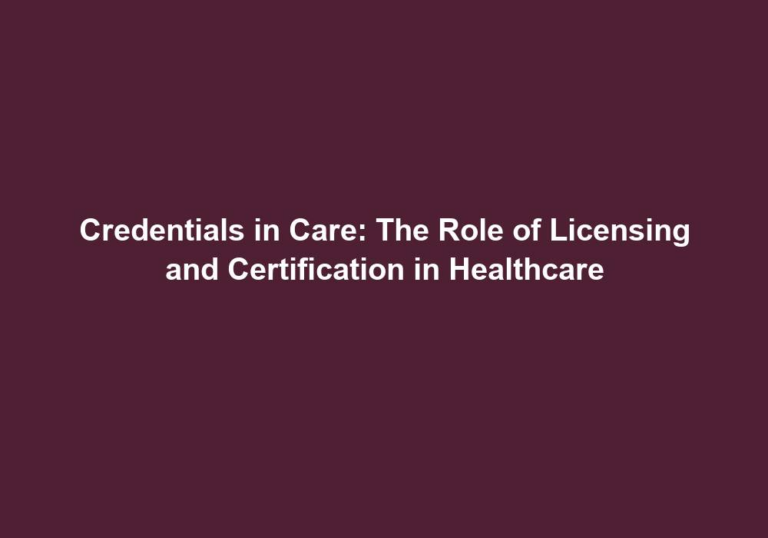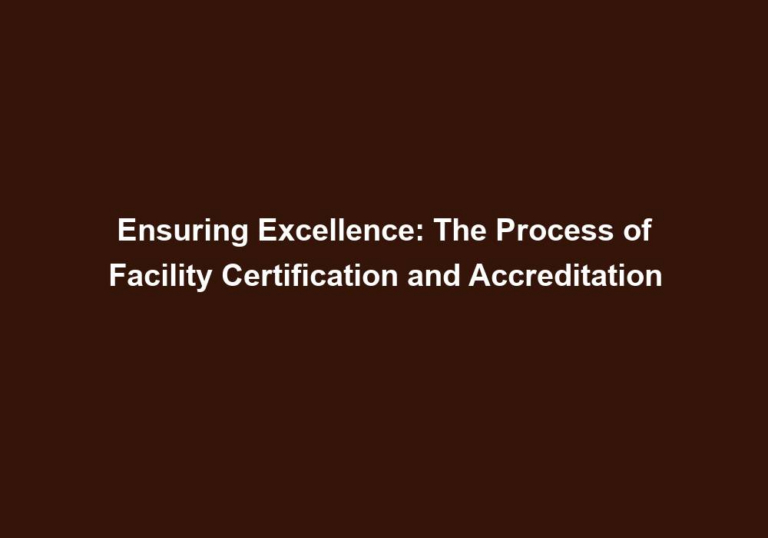Safe Havens of Health: Navigating Facility Certification and Accreditation
In the realm of healthcare, ensuring the safety and quality of facilities is paramount. Facility certification and accreditation play a vital role in guaranteeing that healthcare establishments meet rigorous standards and provide optimal care to patients. By achieving these certifications, healthcare facilities become safe havens of health, instilling trust in patients and enabling them to receive the best possible care. Let’s delve into the world of facility certification and accreditation, exploring their significance and the steps involved in obtaining them.
Understanding Facility Certification
Facility certification is a process by which a healthcare facility is officially recognized as meeting certain standards set by regulatory bodies. This certification is generally issued by government agencies or authorized organizations that conduct thorough assessments of the facility’s infrastructure, practices, and patient care procedures.
Importance of Facility Certification
- Ensuring Patient Safety: Facility certification serves as a guarantee that a healthcare facility adheres to specific safety measures, reducing the risk of accidents, infections, and medical errors. This ensures that patients receive care in a safe environment.
Certification ensures that healthcare facilities have implemented robust safety protocols, such as proper sanitation practices, effective infection control measures, and adherence to patient safety guidelines. By complying with these standards, facilities can minimize the risk of accidents, infections, and medical errors, creating a safe environment for patients.
- Enhancing Trust and Credibility: Certification provides reassurance to patients, indicating that the facility meets recognized standards of quality and care. It enhances the facility’s reputation and credibility, attracting more patients and fostering trust within the community.
When a healthcare facility receives certification, it demonstrates its commitment to delivering high-quality care and meeting established standards. Patients are more likely to trust and choose a certified facility, as it signifies that the facility has undergone a rigorous evaluation and has been found to meet the necessary requirements. This enhances the facility’s reputation and credibility, attracting a larger patient base and fostering trust within the community.
- Promoting Continuous Improvement: The certification process encourages healthcare facilities to continuously improve their practices and strive for excellence. This ongoing commitment to enhancing patient care leads to better health outcomes and overall quality improvement.
Certification serves as a catalyst for continuous improvement within healthcare facilities. By complying with certification standards, facilities are constantly motivated to evaluate and enhance their practices and operations. This focus on continuous improvement ultimately translates into better patient care, improved health outcomes, and an overall elevation of the quality of services provided.
Types of Facility Certifications
- National Accreditation: Many countries have established national accreditation programs that set standards for healthcare facilities. These programs assess various aspects, including patient safety, infection control, staff competence, and facility management.
National accreditation programs ensure that healthcare facilities within a specific country meet the established standards of care. These programs evaluate various aspects, such as patient safety protocols, infection control practices, staff qualifications and competencies, and the overall management of the facility. By achieving national accreditation, healthcare facilities demonstrate their commitment to providing high-quality care that aligns with the country’s standards.
- Specialized Certifications: Certain healthcare specialties have their own certification programs, such as trauma center certification, stroke center certification, or cancer center certification. These specialized certifications validate a facility’s expertise in delivering specific types of care.
In addition to national accreditation, healthcare facilities can also pursue specialized certifications that focus on specific areas of care. For example, trauma center certification validates a facility’s ability to provide specialized care for trauma patients, while stroke center certification recognizes a facility’s proficiency in delivering comprehensive stroke care. These specialized certifications not only highlight a facility’s expertise but also attract patients seeking specialized care for specific medical conditions.
Decoding Facility Accreditation
Facility accreditation goes a step beyond certification, providing a more comprehensive evaluation of a healthcare facility’s overall performance. Accreditation entails undergoing an extensive assessment by an independent accrediting body, which evaluates the facility against a set of predetermined criteria.
Significance of Facility Accreditation
- Meeting Internationally Recognized Standards: Accreditation ensures that healthcare facilities meet internationally recognized standards of care. It allows facilities to benchmark their performance against these standards, driving continuous improvement and fostering a culture of excellence.
Facility accreditation ensures that healthcare facilities meet not only national but also internationally recognized standards of care. Accreditation bodies evaluate facilities against a set of predetermined criteria that reflect best practices in healthcare. By achieving accreditation, facilities can benchmark their performance against these standards, identify areas for improvement, and strive for excellence in patient care.
- Enhancing Patient Satisfaction: Accreditation demonstrates a facility’s commitment to providing high-quality care. Patients are more likely to choose an accredited facility, knowing that it has met stringent quality benchmarks. This positively impacts patient satisfaction and overall experience.
Accreditation plays a crucial role in enhancing patient satisfaction. When patients choose an accredited facility, they have confidence in the facility’s commitment to providing high-quality care. Accreditation serves as an assurance that the facility has met rigorous quality benchmarks and has undergone a comprehensive evaluation by an independent accrediting body. This assurance translates into a positive patient experience, increased satisfaction, and trust in the facility.
- Facilitating Cross-Border Collaboration: Accreditation plays a vital role in facilitating cross-border collaboration between healthcare organizations. In international healthcare, accreditation acts as a common language that enables seamless coordination and referral of patients.
Accreditation serves as a common language in the international healthcare landscape. When healthcare organizations from different countries have achieved accreditation, it signifies that they have met internationally recognized standards of care. This common ground enables seamless collaboration, coordination, and referral of patients across borders. Accreditation facilitates the exchange of knowledge and best practices, ultimately benefiting patients who seek care in different parts of the world.
Accreditation Bodies
- The Joint Commission: The Joint Commission is a well-known accrediting body in the United States, setting the standards for quality and safety in healthcare organizations.
The Joint Commission is a prominent accrediting body in the United States, responsible for setting the standards of quality and safety in healthcare organizations. It evaluates various aspects of healthcare facilities, including patient care, infection control, medication management, and facility management. The Joint Commission’s accreditation is highly regarded and signifies a facility’s commitment to meeting rigorous quality and safety standards.
- Commission on Accreditation of Rehabilitation Facilities (CARF): CARF focuses on accrediting rehabilitation facilities, ensuring they meet specific standards in areas such as physical therapy, occupational therapy, and rehabilitation services.
CARF specializes in accrediting rehabilitation facilities, ensuring that they meet specific standards in areas such as physical therapy, occupational therapy, and rehabilitation services. The accreditation process evaluates the facility’s programs, practices, and outcomes to ensure that patients receive high-quality rehabilitation care. CARF accreditation demonstrates a facility’s expertise in providing specialized rehabilitation services.
- International Society for Quality in Health Care (ISQua): ISQua is a global accreditation organization that evaluates healthcare facilities worldwide, promoting quality and safety in patient care.
ISQua is a global accreditation organization dedicated to evaluating healthcare facilities worldwide. It promotes quality and safety in patient care by assessing facilities against international standards. ISQua accreditation signifies a facility’s commitment to providing high-quality healthcare that aligns with global best practices. It enables healthcare facilities to gain international recognition and attract patients seeking high-quality care from different parts of the world.
The Certification and Accreditation Process
Obtaining facility certification and accreditation involves a comprehensive and systematic process. While the specific steps may vary depending on the accrediting body and country, the general process typically includes the following:
- Self-Assessment: Healthcare facilities conduct an internal evaluation to identify areas of strength and areas that need improvement.
Before pursuing certification or accreditation, healthcare facilities conduct a self-assessment to evaluate their current practices, processes, and infrastructure. This self-assessment helps identify areas of strength that can be highlighted during the certification or accreditation process, as well as areas that require improvement. It serves as a starting point for the facility to implement necessary changes in order to meet the required standards.
- Application Submission: Facilities submit the necessary paperwork and documentation to the accrediting body, which initiates the accreditation process.
Once the self-assessment is complete, healthcare facilities submit the necessary paperwork and documentation to the accrediting body. This includes information about the facility’s infrastructure, policies and procedures, staff qualifications, patient care protocols, and other relevant documentation. The submission of the application marks the formal initiation of the accreditation process.
- On-Site Assessment: Accreditation surveyors visit the facility to conduct an on-site evaluation. They assess various aspects, including patient care, staff competence, infection control, safety protocols, and facility management.
Accreditation surveyors, appointed by the accrediting body, visit the healthcare facility to conduct an on-site evaluation. During this assessment, the surveyors evaluate various aspects of the facility, including patient care practices, staff competence and qualifications, infection control measures, safety protocols, and overall facility management. The surveyors may observe patient interactions, review medical records, and interview staff members to gather information and assess compliance with accreditation standards.
- Evaluation and Decision: The accrediting body thoroughly reviews the survey findings and determines whether the facility meets the required standards for certification or accreditation.
After the on-site assessment, the accrediting body thoroughly reviews the survey findings and evaluates the facility’s compliance with the accreditation standards. The review process includes a detailed analysis of the survey report, documentation provided by the facility, and any additional information gathered during the assessment. Based on this evaluation, the accrediting body makes a decision regarding the facility’s certification or accreditation status.
- Ongoing Compliance: Certified or accredited facilities must maintain ongoing compliance with the standards set by the accrediting body. Regular assessments or surveys are conducted to ensure continued adherence to these standards.
Certified or accredited facilities are required to maintain ongoing compliance with the standards set by the accrediting body. This involves implementing and sustaining best practices, continuously improving processes, and regularly monitoring adherence to the accreditation standards. The accrediting body may conduct periodic assessments or surveys to ensure that the facility continues to meet the required standards. Ongoing compliance is essential to maintain certification or accreditation status.
Benefits of Certification and Accreditation
- Improved Patient Outcomes: By adhering to rigorous standards, certified and accredited facilities provide safer and more effective care, leading to improved patient outcomes.
Certified and accredited facilities adhere to rigorous standards of care, which directly contribute to improved patient outcomes. These facilities implement evidence-based practices, maintain a focus on patient safety, and continuously strive for excellence in patient care. By following these standards, certified and accredited facilities enhance the overall quality of care and contribute to better health outcomes for their patients.
- Enhanced Reputation: Certification and accreditation enhance a facility’s reputation, instilling confidence in patients, healthcare providers, and the community.
Certification and accreditation are recognized symbols of excellence in healthcare. When a facility achieves certification or accreditation, it demonstrates its commitment to meeting rigorous standards and delivering high-quality care. This enhances the facility’s reputation and instills confidence in patients, healthcare providers, and the community at large. A strong reputation as a certified or accredited facility attracts more patients and fosters trust among stakeholders.
- Staff Engagement and Development: The process of certification and accreditation engages and empowers healthcare professionals, fostering a culture of continuous learning and improvement.
Certification and accreditation involve the active participation of healthcare professionals within the facility. The process engages them in self-assessment, implementation of best practices, and ongoing quality improvement initiatives. This engagement empowers healthcare professionals, as they actively contribute to the delivery of high-quality care. Certification and accreditation also promote a culture of continuous learning and improvement, encouraging staff members to stay updated with the latest advancements in their respective fields.
- International Recognition: Accreditation enables healthcare facilities to gain international recognition, attracting patients from different parts of the world seeking high-quality care.
Accreditation opens doors to international recognition for healthcare facilities. When a facility achieves accreditation, it signifies that it meets internationally recognized standards of care. This recognition attracts patients from different parts of the world who are seeking high-quality care. Accredited facilities are more likely to be considered by international patients due to the assurance of meeting rigorous quality benchmarks.
- Quality Benchmarking: Certification and accreditation provide a benchmark against which facilities can measure their performance and identify areas for improvement.
Certification and accreditation serve as benchmarks for healthcare facilities to measure their performance against established standards. Facilities can compare their practices, policies, and outcomes with the accreditation criteria, identifying areas for improvement and implementing necessary changes. This continuous quality benchmarking process helps facilities stay at the forefront of best practices and deliver the highest level of care to their patients.
In conclusion, facility certification and accreditation are essential in ensuring the safety, quality, and credibility of healthcare establishments. These processes not only benefit the patients but also contribute to the overall improvement of healthcare systems. By navigating the complex landscape of certifications and accreditations, healthcare facilities become safe havens of health – places where patients can trust that they will receive the best possible care.






